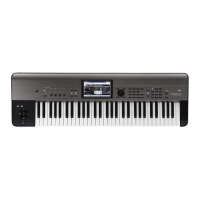SEQ P7: ARP/DT (Arpeggiator/DrumTrack) 7–5: ARP Scan Zone
145
•10:
Copy from Combination
see p. 166
•11: Copy from Program see p. 101
•12: Copy Arpeggiator see p. 103
For more information, please see “Sequencer: Menu
Command” on page 163.
7–5: ARP Scan Zone
These settings specify the note and velocity ranges that will
operate arpeggiators A and B.
7–5a: Location, Meter, Tempo, Tempo
Mode, Song Select, Track Select,
Reso, RPPR
7–5b: Track Info
For more information, please see “0–1(2)a: Location, Meter,
Tempo, Tempo Mode, Song Select, Track Select, Reso, RPPR”
on page 109.
7–5c: Zone Map
This shows the Scan Zone for each arpeggiator, A and B.
For more information, please see “7–5b: Zone Map” on
page 93.
7–5d: Scan Zone
A:, B:
Top Key [C–1...G9]
Bottom Key [C–1...G9]
Specifies the range of notes (keys) that will operate
arpeggiator A (B). Top Key specifies the upper limit, and
Bottom Key specifies the lower limit.
Top Velocity [001...127]
Bottom Velocity [001...127]
Specifies the range of velocities that will operate arpeggiator
A (B). Top Velocity specifies the upper limit, and Bottom
Vel oc it y specifies the lower limit.
Specifies the range of notes (keys) and velocities that will
operate arpeggiator A/B.
Note: You can also set the note and velocity values by
holding down an edit cell or the ENTER button and playing
a key (see OG p.10).
V
7–5: Menu Command
•0: Memory Status see p. 163
•1: Exclusive Solo see p. 64
•2: Rename Song see p. 163
•3: Delete Song see p. 163
•4: Copy From Song see p. 163
•5: Load Template Song see p. 163
•6: Save Template Song (Save as User Template Song)
see p. 164
•7: FF/REW Speed see p. 164
•8: Set Location (Set Location for Locate Key) see p. 164
•9: GM Initialize see p. 165
•10:
Copy from Combination
see p. 166
•11: Copy from Program see p. 101
•12: Copy Arpeggiator see p. 66
For more information, please see “Sequencer: Menu
Command” on page 163.
7–7: Drum Track
The parameters for the Drum Track function are structured
in the same way as in Combination mode. Assign the Drum
Track program to the desired track 1–16.
However, while a combination triggers the Drum Track
pattern on the global MIDI channel, a song triggers the
Drum Track pattern on the MIDI channel specified by Drum
Pattern Input. Normally you’ll set this to Tch. With the Tch
setting, the MIDI channel of the track selected by Track
Select will automatically be used as the trigger channel.
In Sequencer mode you can use the Drum Track function
while realtime‐recording a song track or pattern.
The note‐on/off data transmitted by the Drum Track pattern
can be recorded as events in a track or pattern.
You can’t use note data from the internal sequencer as a
trigger to start patterns for the Drum Track function.
When you’ve used the Drum Track function with a program
or combination to come up with an idea for a song, you can
then use the Auto Song Setup function to immediately start
realtime‐recording (see p.106).
MIDI transmission and reception for the drum
track
In Sequencer mode, the Drum Track function transmits and
receives on the following MIDI channels.
Receive: The drum track will receive on the MIDI channel
specified by the Drum Pattern Input setting of each song.
Normally you’ll set this to Tch and use the KROME’s
keyboard to control the triggering.
Transmit: The drum track will transmit on the MIDI channel
specified by the Drum Pattern Output setting of each song.

